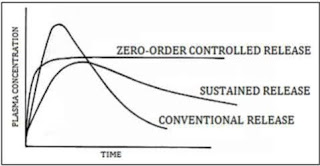Carbonic anhydrase inhibitors
Bicarbonate
reabsorption is initiated by the action of Na+/H+ ion
exchanger which allows Na+ to enter into the cell and hydrogen into
lumen part of nephron.
In
the lumen bicarbonate is Combined with H+ and form carbonic acid
which is rapidly dehydrated to H2O and CO2 with the help
of an enzyme and Carbonic anhydrase. CO2 enters Into the epithelial
cell by Simple diffusion and get H2O
to form Carbonic acid by intracellular Carbonic anhydrase. Now, this
intracellular Carbonic acid dissociates to forms hydrogen ion and bicarbonate. This
hydrogen ion (H+) gets back to the lumen through Na+/H+
ion exchanger and bicarbonate Ion (HCO3) is transported to the
blood. When Carbonic anhydrase inhibitors are introduced they inhibit Carbonic
anhydrase enzyme which reduces the reabsorption of bicarbonate.
Now
due to this excessive fluid is excrted out in urine and helps to treat disease
like Hypertention,Edema etc.
Exm:
Acetazolamide
Pharmacokinetics
Acetazolamide
is well absorbed orally and excreted unchanged in urine. Action of a single
dose lasts 8–12 hours.
Uses:
I.
Used
as mild uritic agents.
II.
used
in the treatment of gloucoma and drug induced edema.
III.
also
used as anticonvulsant for treatment of epilepsy.
IV.
Also
used in the treatment of menier’s disease.
Adverse effects are frequent.
I. Acidosis, hypokalaemia, drowsiness, paresthesias, fatigue, abdominal discomfort.
II. Hypersensitivity reactions—fever, rashes.
III. Bone
marrow depression is rare but serious.
IV. It
is contraindicated in liver disease: may precipitate hepatic coma by
interfering with urinary elimination of NH3 (due to alkaline urine).
V. Acidosis
is more likely to occur in patients of COPD.




Comments
Post a Comment
Thanks